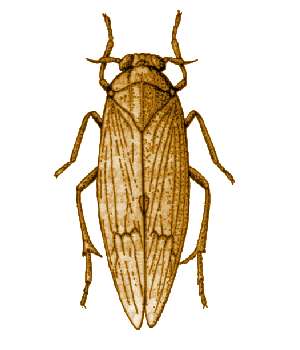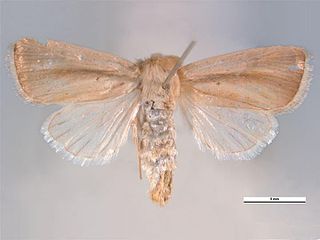
Orthoptera is an order of insects that comprises the grasshoppers, locusts, and crickets, including closely related insects, such as the bush crickets or katydids and wētā. The order is subdivided into two suborders: Caelifera – grasshoppers, locusts, and close relatives; and Ensifera – crickets and close relatives.

The Chinese red-headed centipede, also known as the Chinese red head, is a centipede from East Asia and Australasia. It averages 20 cm (8 in) in length and lives in damp environments.

The brown planthopper (BPH), Nilaparvata lugens (Stål) is a planthopper species that feeds on rice plants. These insects are among the most important pests of rice, which is the major staple crop for about half the world's population. They damage rice directly through feeding and also by transmitting two viruses, rice ragged stunt virus and rice grassy stunt virus. Up to 60% yield loss is common in susceptible rice cultivars attacked by the insect. The BPH is distributed throughout Australia, Bangladesh, Bhutan, Burma (Myanmar), Cambodia, China, Fiji, India, Indonesia, Japan, North and South Korea, Laos, Malaysia, India, Nepal, Pakistan, Papua New Guinea, Philippines, Sri Lanka, Taiwan, Thailand, and Vietnam. Their alternative host plant other than rice is Leersia hexandra.
In human mitochondrial genetics, Haplogroup G is a human mitochondrial DNA (mtDNA) haplogroup.

Honokiol is a lignan isolated from the bark, seed cones, and leaves of trees belonging to the genus Magnolia. It has been identified as one of the chemical compounds in some traditional eastern herbal medicines along with magnolol, 4-O-methylhonokiol, and obovatol.
Raymond J. St. Leger is an American mycologist, entomologist, molecular biologist and biotechnologist who currently holds the rank of Distinguished University Professor in the Department of Entomology at the University of Maryland, College Park.

Cornus officinalis, the Japanese cornel or Japanese cornelian cherry, is a species of flowering plant in the dogwood family Cornaceae. Despite its name, it is native to China and Korea as well as Japan. It is not to be confused with C. mas, which is also known as the Cornelian cherry. It is not closely related to the true cherries of the genus Prunus.

Leonurine is a pseudoalkaloid that has been isolated from Leonotis leonurus, Leonotis nepetifolia, Leonurus japonicus, Leonurus cardiaca (motherwort), Leonurus sibiricus, as well as other plants of family Lamiaceae. Leonurine is easily extracted into water.

Salidroside (rhodioloside) is a glucoside of tyrosol found in the plant Rhodiola rosea. It has been studied, along with rosavin, as one of the potential compounds responsible for the putative antidepressant and anxiolytic actions of this plant. Salidroside may be more active than rosavin, even though many commercially marketed Rhodiola rosea extracts are standardized for rosavin content rather than salidroside.

The Tiaojishan Formation is a geological formation in Hebei and Liaoning, People's Republic of China, dating to the middle-late Jurassic period. It is known for its exceptionally preserved fossils, including those of plants, insects and vertebrates. It is made up mainly of pyroclastic rock interspersed with basic volcanic and sedimentary rocks. Previously, the Tiaojishan Formation was grouped together with the underlying Haifanggou Formation as a single "Lanqi Formation." The Tiaojishan Formation forms a key part of the Yanliao Biota assemblage, alongside the Haifanggou Formation.

The Korean brown frog is a species of frog in the genus Rana. It is native to the Korean Peninsula and Shandong, China.

China participated and hosted the 2010 Asian Games in Guangzhou on 12–27 November 2010.

The tables below provide statistics on the human Y-chromosome DNA haplogroups most commonly found among ethnolinguistic groups and populations from East and South-East Asia.

Sesamia inferens, the Asiatic pink stem borer, gramineous stem borer, pink borer, pink rice borer, pink rice stem borer, pink stem borer, purple borer, purple stem borer or purplish stem borer, is a moth of the family Noctuidae. The species was first described by Francis Walker in 1856. It is found from Pakistan, India, Sri Lanka, Myanmar to Japan and the Solomon Islands. A polyphagous species, it is a major pest in many crops worldwide.
Saccharopolyspora spinosa is a species of actinobacterium first isolated from soil in a rum still in an abandoned sugar mill on the Virgin Islands. It was discovered and described by researchers Mertz and Yao while collecting specimens to be screened for novel antibiotics. It develops aerial, pale, yellowish pink hyphae and bears long chains of spores encased in spiny spore sheaths. It can also reproduce by fragmentation in an aqueous environment. Its type strain is A83543.1.
Insect tea refers to teas made from leaves bitten by, and the droppings of, insects fed on specific plants. Most insect teas originate from the Southeast Asian region. They are often used in local traditional medicine, but have not been well-studied in the scientific literature.
The iodate fluorides are chemical compounds which contain both iodate and fluoride anions (IO3− and F−). In these compounds fluorine is not bound to iodine as it is in fluoroiodates.
Sulfidogermanates or thiogermanates are chemical compounds containing anions with sulfur atoms bound to germanium. They are in the class of chalcogenidotetrelates. Related compounds include thiosilicates, thiostannates, selenidogermanates, telluridogermanates and selenidostannates.

Makatoxin-3 is an α-like scorpion neurotoxin found in the venom of Olivierus martensii. Makatoxin-3 both enhances the activation and slows down the inactivation of voltage-gated NaV1.7 channels, resulting in hyperexcitability of the neurons involved in pain perception.
Anastatus disparis is a species of egg parasitoid. Hosts include Lymantria dispar and Antheraea pernyi. The species is sexually dimorphic, with 630 sex specific genes. Females have 11 antennal subsegments, whereas males have 8. Females only mate once, and males are significantly shorter lived than females, engaging in agonistic behavior.













